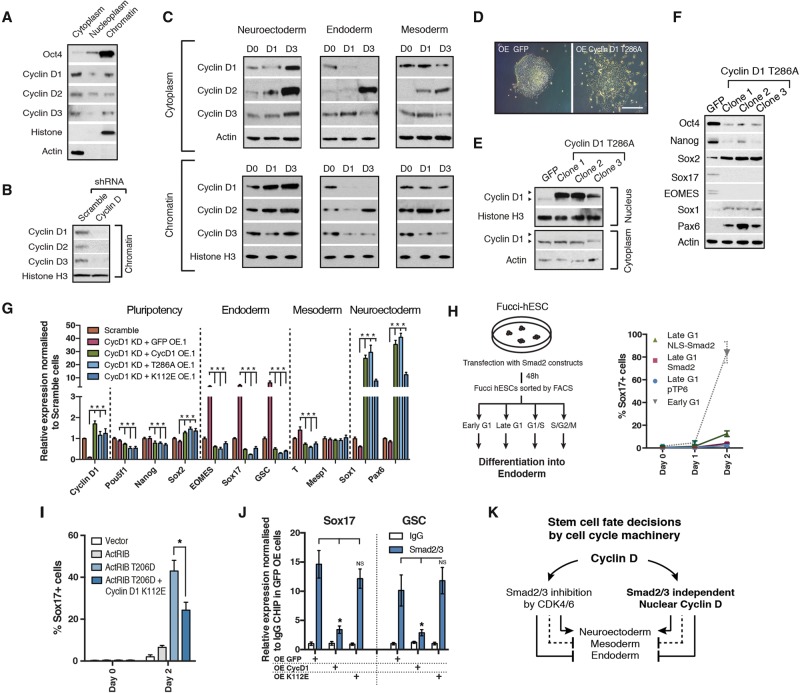Figure 2.
Nuclear Cyclin D binds to developmental loci and induces neuroectoderm while blocking endoderm differentiation in hESCs. (A) Cyclin D is localized both in the cytoplasm and on chromatin in hESCs. Cytoplasm, nucleoplasm, and chromatin were isolated from H9 cells and analyzed for Cyclin D1–3 protein by Western blot. Oct4 was used as a positive control. (B) Cyclin D knockdown in chromatin fractions. Chromatin fractions isolated from H9 cells expressing Scramble, Cyclin D1, Cyclin D2, or Cyclin D3 shRNA were analyzed for Cyclin Ds by Western blot. (C) Cyclin D cellular location during differentiation. H9 hESCs were differentiated into neuroectoderm, endoderm, and mesoderm. Cytoplasm and chromatin fractions were isolated and analyzed for relative Cyclin D1–3 levels by Western blot. Actin and Histone H3 acted as loading controls for cytoplasm and chromatin, respectively. (D) Morphology of hESCs overexpressing the Cyclin D1 T286A (CycD1-T286A) mutant. Representative colonies of hESCs overexpressing GFP and CycD1-T286A. (E) The CycD1-T286A mutant accumulates in the nucleus of hESCs. Western blot of Cyclin D1 in the cytoplasmic fraction and nucleoplasm. (F,G) CycD1-T286A overexpression causes neuroectoderm differentiation. Expression of neuroectoderm markers in CycD1-T286A-overexpressing cells shown by Western blot (F) and quantitative PCR (qPCR) (G). Significant differences compared with overexpressing GFP and calculated by two-way ANOVA are marked. (H) Nuclear Smad2 cannot bypass endoderm inhibition in late G1 cells. (Left panel) Schematic overview of the experiment. Tra-1–60-positive Fucci hESCs were sorted into early G1, late G1, and S/G2/M phase and differentiated into endoderm. (Right panel) Fucci hESCs transfected with Smad2 constructs 48 h before cell sorting were selected for 12 h with the goal of removing nontransfected cells and then sorted into late G1 phase and analyzed for marker expression by flow cytometry 1 or 2 d after endoderm differentiation. (I) CycD1-K112E cells can block endoderm and induce neuroectoderm differentiation in the presence of constitutively activated Activin–Smad2/3 signaling. Analysis of Sox17 expression by flow cytometry in cells transfected with ActRIB-expressing constructs. Significant differences calculated by t-test are marked. (J) CycD1-K112E regulates differentiation without affecting Smad2/3 binding to its target loci. Smad2/3 chromatin immunoprecipitation (ChIP) was performed in cells expressing GFP, Cyclin D1, or CycD1-K112E. Significant differences calculated by t-test are marked. (K) Schematics of dual mechanistically distinct functions for Cyclin D proteins in stem cell fate decisions. Cyclin Ds can repress endoderm in the cytoplasm by inhibiting Smad2/3 via CDK4/6 activation as shown before. Cyclin D proteins can also regulate cell fate decisions in stem cells in the nucleus that are independent of CDK4/6 and Smad2/3. All data are shown as mean ± SD. n = 3.

